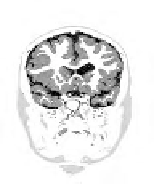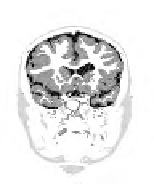Image Processing Reference
In-Depth Information
FIGURE 2.7
I-20497777: segmented versions of HCM, FCM, RCM, and RFCM
to FCM. But, the performance of RFCM with respect to DB, Dunn, and β is
significantly better than all other c-means. The performance of FCM and RCM
is intermediate between RFCM and HCM.
2. The discriminant analysis based initialization is found to improve the values of
DB, Dunn, and β as well as reduce the time requirement substantially for all
c-means algorithms.
3. Two features proposed in (Maji and Pal, 2008) are as important as Haralick's
ten features for clustering based segmentation of brain MR images.
4. Use of rough sets and fuzzy memberships adds a small computational load to
HCM algorithm; however the corresponding integrated method (RFCM) shows
a definite increase in Dunn index and decrease in DB index.
The best performance of the segmentation method in terms of DB, Dunn, and β is
achieved due to the following reasons:
1. the discriminant analysis based initialization of centroids enables the algorithm
to converge to an optimum or near optimum solutions;
2. membership of the RFCM handles e
ciently overlapping partitions; and
3. the concept of crisp lower bound and fuzzy boundary of the RFCM algorithm
deals with uncertainty, vagueness, and incompleteness in class definition.
In effect, promising segmented brain MR images are obtained using the RFCM algorithm.
2.7
Conclusion
A robust segmentation technique is presented in this chapter, integrating the merits of
rough sets, fuzzy sets, and c-means algorithm, for brain MR images. Some new measures
are reported, based on the local properties of MR images, for accurate segmentation. The
method, based on the concept of maximization of class separability, is found to be suc-
cessful in effectively circumventing the initialization and local minima problems of iterative
refinement clustering algorithms like c-means. The effectiveness of the algorithm, along
with a comparison with other algorithms, is demonstrated on a set of brain MR images.
The extensive experimental results show that the rough-fuzzy c-means algorithm produces
a segmented image more promising than do the conventional algorithms.
The authors thank Advanced Medicare and Research Institute, Kolkata, India, for providing
brain MR images. This work was done when S. K. Pal was a Govt. of India J.C. Bose Fellow.














Search WWH ::

Custom Search